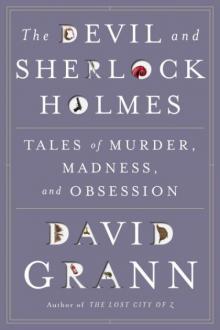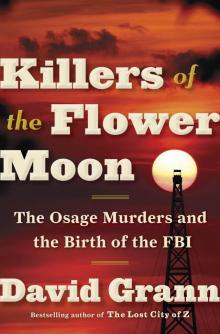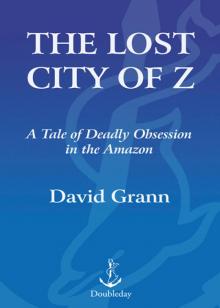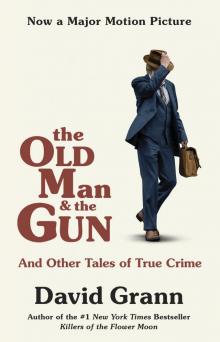- Home
- David Grann
The Old Man and the Gun Page 6
The Old Man and the Gun Read online
Page 6
* * *
—
“I have infected you,” Chris warns the reader at the beginning of “Amok.” “You will not be able to get free of me.” Wroblewski remained haunted by one riddle in the novel, which, he believed, was crucial to solving the case. A character asks Chris, “Who was the one-eyed man among the blind?” The phrase derives from Erasmus (1469–1536), the Dutch theologian and classical scholar, who said, “In the kingdom of the blind, the one-eyed man is king.” Who in “Amok,” Wroblewski wondered, was the one-eyed man? And who were the blind men? In the novel’s last line, Chris suddenly claims that he has solved the riddle, explaining, “This was the one killed by blind jealousy.” But the sentence, with its strange lack of context, made little sense.
One hypothesis based on “Amok” was that Bala had murdered Janiszewski after beginning a homosexual affair with him. In the novel, after Chris’s closest friend confesses that he is gay, Chris says that part of him wanted to “strangle him with a rope” and “chop a hole in a frozen river and dump him there.” Still, the theory seemed dubious. Wroblewski had thoroughly investigated Janiszewski’s background and there was no indication that he was gay.
Another theory was that the murder was the culmination of Bala’s twisted philosophy—that he was a postmodern version of Nathan Leopold and Richard Loeb, the two brilliant Chicago students who, in the nineteen-twenties, were so entranced by Nietzsche’s ideas that they killed a fourteen-year-old boy to see if they could execute the perfect murder and become supermen. At their trial, in which they received life sentences, Clarence Darrow, the legendary defense attorney who represented them, said of Leopold, “Here is a boy at sixteen or seventeen becoming obsessed with these doctrines. It was not a casual bit of philosophy with him; it was his life.” Darrow, trying to save the boys from the death penalty, concluded, “Is there any blame attached because somebody took Nietzsche’s philosophy seriously and fashioned his life upon it?…It is hardly fair to hang a nineteen-year-old boy for the philosophy that was taught him at the university.”
In “Amok,” Chris clearly aspires to be a postmodern Übermensch, speaking of his “will to power” and insisting that anyone who is “unable to kill should not stay alive.” Yet these sentiments did not fully explain the murder of the unknown man in the novel, who, Chris says, had “behaved inappropriately” toward him. Chris, alluding to what happened between them, says teasingly, “Maybe he didn’t do anything significant, but the most vicious Devil is in the details.” If Bala’s philosophy had justified, in his mind, a break from moral constraints, including the prohibition on murder, these passages suggested that there was still another motive, a deep personal connection to the victim—something that the brutality of the crime also indicated. With Bala unable to leave Poland, Wroblewski and his team began to question the suspect’s closest friends and family.
Many of those interrogated saw Bala positively—“a bright, interesting man,” one of his former girlfriends said of him. Bala had recently received a reference from a past employer at an English-instruction school in Poland, which described him as “intelligent,” “inquisitive,” and “easy to get along with,” and praised his “keen sense of humor.” The reference concluded, “With no reservation, I highly recommend Krystian Bala for any teaching position with children.”
Yet, as Wroblewski and his men deepened their search for the “Devil in the details,” a darker picture of Bala’s life began to emerge. The years 1999 and 2000, during which time his business and his marriage collapsed—and Janiszewski was murdered—had been especially troubled. A friend recalled that Bala once “started to behave vulgarly and wanted to take his clothes off and show his manliness.” The family babysitter described him as increasingly drunk and out of control. She said he constantly berated his wife, Stasia, shouting at her that “she slept around and cheated on him.”
According to several people, after Bala and his wife separated, in 2000, he remained possessive of her. A friend, who called Bala an “authoritarian type,” said of him, “He continuously controlled Stasia, and checked her phones.” At a New Year’s Eve party in 2000, just weeks after Janiszewski’s body was found, Bala thought a bartender was making advances toward his wife and, as one witness put it, “went crazy.” Bala screamed that he would take care of the bartender and that he had “already dealt with such a guy.” At the time, Stasia and her friends had dismissed his drunken outburst. Even so, it took five people to restrain Bala; as one of them told police, “He was running amok.”
As Wroblewski and his men were trying to fix on a motive, other members of the squad stepped up their efforts to trace the two suspicious telephone calls that had been made to Janiszewski’s office and to his cell phone on the day he disappeared. The public telephone from which both calls were made was operated with a card. Each card was embedded with a unique number that registered with the phone company whenever it was used. Not long after Bala was released, the telecommunications expert on the Janiszewski case was able to determine the number on the caller’s card. Once the police had that information, officials could trace all the telephone numbers dialled with that same card. Over a three-month period, thirty-two calls had been made. They included calls to Bala’s parents, his girlfriend, his friends, and a business associate. “The truth was becoming clearer and clearer,” Wroblewski said.
Wroblewski and his team soon uncovered another connection between the victim and the suspect. Malgorzata Drozdzal, a friend of Stasia’s, told the police that in the summer of 2000 she had gone with Stasia to a night club called Crazy Horse, in Wroclaw. While Drozdzal was dancing, she saw Stasia talking to a man with long hair and bright-blue eyes. She recognized him from around town. His name was Dariusz Janiszewski.
Wroblewski had one last person to question: Stasia. But she had steadfastly refused to cooperate. Perhaps she was afraid of her ex-husband. Perhaps she believed Bala’s claim that he was being persecuted by the police. Or perhaps she dreaded the idea of one day telling her son that she had betrayed his father.
Wroblewski and his men approached Stasia again, this time showing her sections of “Amok,” which was published after she and Bala had split up, and which she had never looked at closely. According to Polish authorities, Stasia examined passages involving Chris’s wife, Sonya, and was so disturbed by the character’s similarities to her that she finally agreed to talk.
She confirmed that she had met Janiszewski at Crazy Horse. “I had ordered French fries, and I asked a man next to the bar whether the French fries were ready,” Stasia recalled. “That man was Dariusz.” They spent the entire night talking, she said, and Janiszewski gave her his phone number. Later, they went on a date and checked into a motel. But before anything happened, she said, Janiszewski admitted that he was married, and she left. “Since I know what it’s like to be a wife whose husband betrays her, I didn’t want to do that to another woman,” Stasia said. The difficulties in Janiszewski’s marriage soon ended, and he and Stasia never went out together again.
Several weeks after her date with Janiszewski, Stasia said, Bala showed up at her place in a drunken fury, demanding that she admit to having an affair with Janiszewski. He broke down the front door and struck her. He shouted that he had hired a private detective and knew everything. “He also mentioned that he had visited Dariusz’s office, and described it to me,” Stasia recalled. “Then he said he knew which hotel we went to and what room we were in.”
Later, when she learned that Janiszewski had disappeared, Stasia said, she asked Bala if he had anything to do with it, and he said no. She did not pursue the matter, believing that Bala, for all his tumultuous behavior, was incapable of murder.
For the first time, Wroblewski thought he understood the last line of “Amok”: “This was the one killed by blind jealousy.”
* * *
—
Spectators flooded into the courtroom in Wroclaw on February
22, 2007, the first day of Bala’s trial. There were philosophers, who argued with each other over the consequences of postmodernism; young lawyers, who wanted to learn about the police department’s new investigative techniques; and reporters, who chronicled every tantalizing detail. “Killing doesn’t make much of an impression in the twenty-first century, but allegedly killing and then writing about it in a novel is front-page news,” a front-page article in Angora, a weekly based in Lodz, declared.
The judge, Lydia Hojenska, sat at the head of the courtroom, beneath an emblem of the white Polish eagle. In accordance with Polish law, the presiding judge, along with another judge and three citizens, acted as the jury. The defense and the prosecution sat at two unadorned wooden tables; next to the prosecutors were Janiszewski’s widow and his parents, his mother holding a picture of her son. The public congregated in the back of the room, and in the last row was a stout, nervous woman with short red hair, who looked as if her own life were at stake. It was Bala’s mother, Teresa; his father was too distraught to attend.
Everyone’s attention, it seemed, was directed toward a zoolike cage near the center of the courtroom. It was almost nine feet high and twenty feet long, and had thick metal bars. Standing in the middle of it, wearing a suit and peering out calmly through his spectacles, was Krystian Bala. He faced up to twenty-five years in prison.
A trial is predicated on the idea that truth is obtainable. Yet it is also, as the writer Janet Malcolm has noted, a struggle between “two competing narratives,” and “the story that can best withstand the attrition of the rules of evidence is the story that wins.” In this case, the prosecution’s narrative resembled that of “Amok”: Bala, like his alter ego Chris, was a depraved hedonist, who, unbound by any sense of moral compunction, had murdered someone in a fit of jealous rage. The prosecution introduced files from Bala’s computer, which Wroblewski and the police had seized during a raid of his parents’ house. In one file, which had to be accessed with the password “amok,” Bala catalogued, in graphic detail, sexual encounters with more than seventy women. The list included his wife, Stasia; a divorced cousin, who was “older” and “plump”; the mother of a friend, described as “old ass, hard-core action”; and a Russian “whore in an old car.” The prosecution also presented e-mails in which Bala sounded unmistakably like Chris, using the same vulgar or arcane words, such as “joy juices” and “Madame Melancholy.” In an angry e-mail to Stasia, Bala wrote, “Life is not only screwing, darling”—which echoed Chris’s exclamation “Fucking is not the end of the world, Mary.” A psychologist testified that “every author puts some part of his personality into his artistic creation,” and that Chris and the defendant shared “sadistic” qualities.
During all this, Bala sat in the cage, taking notes on the proceedings or looking curiously out at the crowd. At times, he seemed to call into question the premise that the truth can be discerned. Under Polish law, the defendant can ask questions directly of the witnesses, and Bala eagerly did so, his professorial inquiries often phrased to reveal the Derridean instability of their testimony. When a former girlfriend testified that Bala once went out on her balcony drunk and acted as if he were on the verge of committing suicide, he asked her if her words might have multiple interpretations. “Could we just say that this is a matter of semantics—a misuse of the word ‘suicide’?” he said.
But, as the trial wore on and the evidence mounted against him, the postmodernist sounded increasingly like an empiricist, a man desperately looking to show gaps in the prosecution’s chain of evidence. Bala noted that no one had seen him kidnap Janiszewski, or kill him, or dump his body. “I’d like to say that I never met Dariusz, and there is not a single witness who would confirm that I did so,” Bala said. He complained that the prosecution was taking random incidents in his personal life and weaving them into a story that no longer resembled reality. The prosecutors were constructing a mytho-creation—or, as Bala’s defense attorney put it to me, “the plot of a novel.” According to the defense, the police and the media had been seduced by the most alluring story rather than by the truth. (Stories about the case had appeared under headlines such as “TRUTH STRANGER THAN FICTION” and “MURDER, HE WROTE.”)
Bala had long subscribed to the postmodernist notion of “the death of the author”—that an author has no more access to the meaning of his literary work than anyone else. Yet, as the prosecution presented to the jury potentially incriminating details from “Amok,” Bala complained that his novel was being misinterpreted. He insisted that the murder of Mary was simply a symbol of the “destruction of philosophy,” and he made one last attempt to assert authorial control. As he later put it to me, “I’m the fucking author! I know what I meant.”
In early September, the case went to the jury. Bala never took the stand, but in a statement he said, “I do believe the court will make the right decision and absolve me of all the charges.” Wroblewski, who had been promoted to inspector, showed up in court, hoping to hear the verdict. “Even when you’re sure of the facts, you wonder if someone else will see them the same way you do,” he told me.
At last, the judges and jurors filed back into the courtroom. Bala’s mother waited anxiously. She had never read “Amok,” which contains a scene of Chris fantasizing about raping his mother. “I started to read the book, but it was too hard,” she told me. “If someone else had written the book, maybe I would have read it, but I’m his mother.” Bala’s father appeared in the courtroom for the first time. He had read the novel, and though he had trouble understanding parts of it, he thought it was an important work of literature. “You can read it ten, twenty times, and each time discover something new in it,” he said. On his copy, Bala had written an inscription to both his parents. It said, “Thank you for your…forgiveness of all my sins.”
As Judge Hojenska read the verdict, Bala stood perfectly straight and still. Then came the one unmistakable word: “Guilty.”
* * *
—
The gray cinder-block prison in Wroclaw looks like a relic of the Soviet era. After I slipped my visitor’s pass through a tiny hole in the wall, a disembodied voice ordered me to the front of the building, where a solid gate swung open and a guard emerged, blinking in the sunlight. The guard waved me inside as the gate slammed shut behind us. After being searched, I was led through several dank interlocking chambers and into a small visitors’ room with dingy wooden tables and chairs. Conditions in Polish prisons are notorious. Because of overcrowding, as many as seven people are often kept in a single cell. In 2004, prison inmates in Wroclaw staged a three-day hunger strike to protest overcrowding, poor food, and insufficient medical care. Violence is also a problem: only a few days before I arrived, I was told, a visitor had been stabbed to death by an inmate.
In the corner of the visitors’ room was a slender, handsome man with wire-rimmed glasses and a navy-blue artist’s smock over a T-shirt that said “University of Wisconsin.” He was holding a book and looked like an American student abroad, and it took me a moment to realize that I was staring at Krystian Bala. “I’m glad you could come,” he said as he shook my hand, leading me to one of the tables. “This whole thing is farce, like something out of Kafka.” He spoke clear English but with a heavy accent, so that his “s”es sounded like “z”s.
Sitting down, he leaned across the table, and I could see that his cheeks were drawn, he had dark circles around his eyes, and his curly hair was standing up in front, as if he had been anxiously running his fingers through it. “I am being sentenced to prison for twenty-five years for writing a book—a book!” he said. “It is ridiculous. It is bullshit. Excuse my language, but that is what it is. Look, I wrote a novel, a crazy novel. Is the book vulgar? Yes. Is it obscene? Yes. Is it bawdy? Yes. Is it offensive? Yes. I intended it to be. This was a work of provocation.” He paused, searching for an example, then added, “I wrote, for instance, that it would be easier for Christ to c
ome out of a woman’s womb than for me—” He stopped, catching himself. “I mean, for the narrator to fuck her. You see, this is supposed to offend.” He went on, “What is happening to me is like what happened to Salman Rushdie.”
As he spoke, he placed the book that he was carrying on the table. It was a worn, battered copy of “Amok.” When I asked Bala about the evidence against him, such as the cell phone and the calling card, he sounded evasive and, at times, conspiratorial. “The calling card is not mine,” he said. “Someone is trying to set me up. I don’t know who yet, but someone is out to destroy me.” His hand touched mine. “Don’t you see what they are doing? They are constructing this reality and forcing me to live inside it.”
He said that he had filed an appeal, which cited logical and factual inconsistencies in the trial. For instance, one medical examiner said that Janiszewski had drowned, whereas another insisted that he had died of strangulation. The judge herself had admitted that she was not sure if Bala had carried out the crime alone or with an accomplice.
When I asked him about “Amok,” Bala became animated and gave direct and detailed answers. “The thesis of the book is not my personal thesis,” he said. “I’m not an anti-feminist. I’m not a chauvinist. I’m not heartless. Chris, in many places, is my anti-hero.” Several times, he pointed to my pad and said, “Put this down” or “This is important.” As he watched me taking notes, he said, with a hint of awe, “You see how crazy this is? You are here writing a story about a story I made up about a murder that never happened.” On virtually every page of his copy of “Amok,” he had underlined passages and scribbled notations in the margins. Later, he showed me several scraps of paper on which he had drawn elaborate diagrams revealing his literary influences. It was clear that, in prison, he had become even more consumed by the book. “I sometimes read pages aloud to my cellmates,” he said.

 The Devil & Sherlock Holmes: Tales of Murder, Madness & Obsession
The Devil & Sherlock Holmes: Tales of Murder, Madness & Obsession Killers of the Flower Moon
Killers of the Flower Moon The Lost City of Z
The Lost City of Z The Old Man and the Gun
The Old Man and the Gun